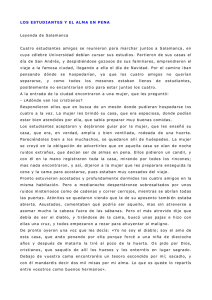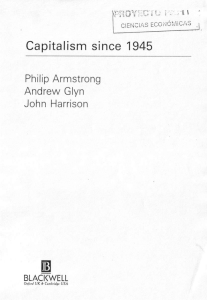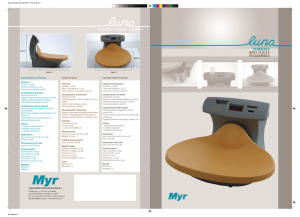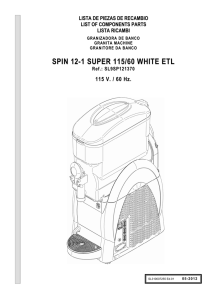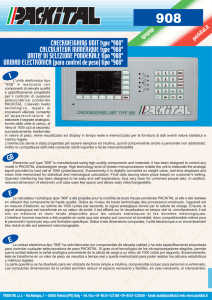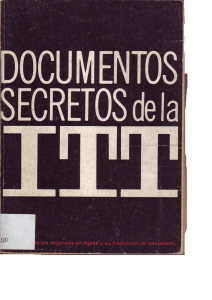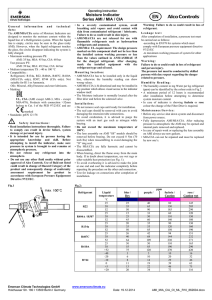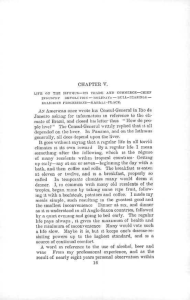Solution of the Schrodinger equation in the field of a magnetic
Anuncio
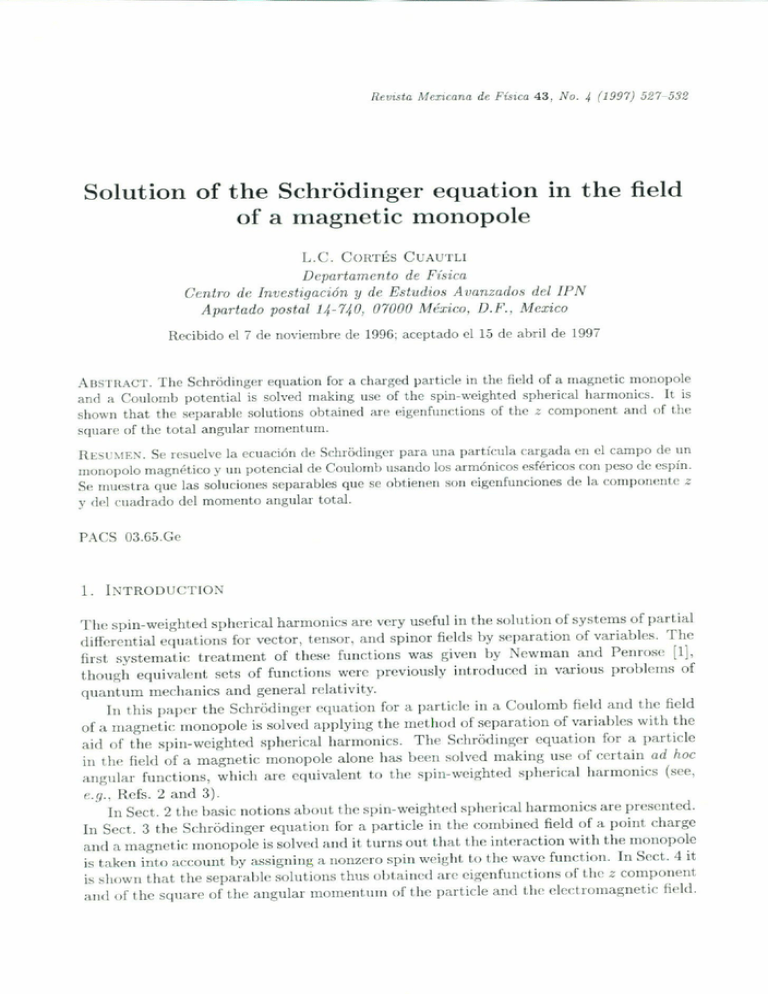
Uevista Mexicana
de Física 43, No.
4
(1997) 527-532
Solution of the Schrodinger equation in the field
of a magnetic monopole
L.C. CarrrÉs CUAUTLI
DC]Hlrtamento
de Fú;ic(L
Centro de Investignción !J de Estudios A vnnZluio8 del IP N
Apartado postnl 11,-740, 11711011México, D.F., Mexico
Hecibido el ,de noviembre de 1996, aceptado el 15 de abril de 199,
A BSTHr\CT. Thc Schr6dinger equatioll for a charged partide in the tield of a magnctic monopole
ami a Coulomh poten ti al is soh"ed making usc of the spin-weightcrl spherical harmonics.
It is
showII that thc separahle solutions ohtained are eigenfunctions of the z compollcnt and of the
square of the t.otal angular morncnt.ulIl.
R ESU~tE:-;. Se rcsueh"c la ecuación de Schr6dingPr para tilla partícula cargada en el campo dc un
mOllopol0 magnético y 11npot.encial de Coulomh usando los armónicos esféricos con peso de pspín.
Se muestra que las soluciones scparahlcs que s(~obtienen son pigenfullciones de la componente z
y d(" cuadrado del momento angular totaL
rAes 03.65.Ge
1.
INTRODUCTION
The spin-weightcd sphcrical harmoIlics arc ver}' llseful itl thc sollltiotl 01'systems of partial
ditrercntial equatiolls for vector: tcnsor and spinor fields by scparation of variables. The
firs1. systematic treatmcnt of these functiolls wa", givcn by Newlllall alld Penrose [1]'
thouglt equivalcnt scts of funetious werc prcviollsly illtrodllcccl in variotls problcllls of
qllantllIll lllcchanics and general rclativity.
lIl this papel' thc Sc}¡rodinger equation 1'01'a partic1e in a Coulomb field and the field
01'a magnctic IIlonopole is sol ved applying the mcthocl of separatioll 01'variablcs with the
aid of the spin-weighted spherieal harmonics. The Sehriidinger e<¡\lation for apartide
in •.he ficld of a magnctie monopole alone }¡,L'" bccn sol ved makillg use of ccrtain ad hoc
angular fUllct.ioIlS, whicIl are cquivalellt t.o the spin-weightcd spherical hannonics (sce,
1
e.!I., [lefs. 2 and 3).
In Sect. 2 the basic notions abont the spin-weighted spherical harmonies are presented.
In Sed. 3 the Schriidinger e<¡\lation for a partide in the combined field of a point ebarge
and a magnct.ic lllonopolc is sol ved and it tllrtlS out that. thc illteraction \vitla the monopole
is t.aklm iut.o accouut by assignillg a Ilouzero spin weight t.o the wave fllIlCt.ioll. In Sed .. 4 it
is shown that. t.hc separable soltltiolls thus obtained are cigcnfundions of the z compollcnt
aud of the sqllare of tlw angular 1Il01llCIlt.1I1I1
of tllc partide all(i t.he c1ectrolllagIlctic fieJe!.
528
L.C.
CORTÉS CUAUTLI
2. SPIN-WEIGIlTED
The spin-weighted
factor, by [1,4)
SPHERICAL
spherical
HARMONICS
e, q,),
.,Yjm(
harmonies,
are defined, up to a normalization
¡jU(sY}m) = [8(8 + 1) - j(j + l)j,Y}m,
D
-iDcjJ
The operators
url
=' -
(J and
=
s}jm
a, actillg
Y
(1)
111, .~ jm.
fUlIction 'TI with spill weight s, are givcn by
011au arbitrary
D
iD)
( DO + sin ODq, -
8
cot
ü raises the Spill weight in ane lIuit,
e '1,
-U'I ='
- (D~" -
a lowcrs
the spin weight
Uf}
iD)
-.-:¡
Slll O uq,
+ s cot O
in olle unit, alld
'l.
s
(2)
Yjm has
spin weight s. From the definitiolls (2) it. follows t.hat
¡jU'Iwhere s is the spin weight of
ID.
UU'I = sin e De
The functiolls
1)
and that
(1)
Slll
(3)
u¡j1) = 2'''1,
e De +
1
sin2
D~'I
.
<:os
e
Drl
82
e Dq,2 + 21"sin~ e Dq, -
s}jm are nOfmalized
according
sin2
0'1 + S(8 +
1)1).
(4)
lo
and the phase of these functions is chosen in such a way that.
U(,Yjm) = J(j
- s)(j
+ 8)(j
¡j(sY}m) =-J(j
oljm are the usual sphcrical
+8+
-
8
1)
.<+1 }jm,
+ 1),_1 Y}m,
ljm. The indiccs
ha.rmonics
."i,
j a1l<1
(5)
111,
of
s ljm can take
t.he values
s=O,:l:~,:l:I, ....
j =
Isl,
18[ + 1, Isl + 2, ...
m=-j,-j+l,
...
,
(u)
,J.
\Vhcn s is au illtcgcr, j alld rn are iutcgcrs alld whcu .., is a half-iuteger, j alld rn are abo
half-integcrs.
As a consequcnce of Eqs. (1), [or él. givcn "aIue of 8, tlle functions sljm are
orthogonal,
thus
(7)
SOLUTIO:-J
OF THE
SCllnODINGER
EQUATION
IN ...
529
Furthermorc, the sct of functiolls .~}jml with s fixed, ÍoS cOlllplete in the seuse that any
quantity with spin weight s can be expanded in a series of the ,Yjm [1).
Using Eqs. (1) and (2) one can show that [5) (cf. also Ref. 3)
.,Yjm(O,c/»
= C(I - cosO)"/2(1
+ cos 0)0/2
l',\",¡l) (cos O)eün</>,
(8)
where p~",O) are the .Jacobi polynolllials,
a
alld
f3
= 1m- si,
n
=
j - ~(a + fI)
=
e ís a normalization
j, rn and s,
3.
= 1m + si,
11,
SOLUTION
constant. Owillg to the rcstrietiollS
is al ways an integcr.
OF THE SCHRODINGER
j - max
OH
the
{lmJ, Isl},
valllcs
(9)
of thc Índices
EQUATION
The tillle-independent
Schriidinger equation for apartide
e in the presence of an electrolllagnetic field produced
magnctic Illollopole g placed al thc origin is givcn by
of mass M amI e1ectric charge
by a point charge -Ze and a
(lO)
whcrc the electromagnctic
potclltials can be taken as
Zc
<p = --,
,.
A
(:¡:I - cos O).
,'sinO
=g-----,e
(11 )
</>.
With the positive sign, the vector potential A is singular on the negative z axis, while
with the negative sign, A diverges on the positive z axis. Tll1ls, we shall consider both
signs in Eqs. (11) in order 1.0 find a well-behaved solution of the Schriidinger equation
everywhere. As shown in Ref. 3, the solutions corresponciing 1.0 the two choices of A can
be joined 1.0 form a section on a !ine bundle provided that
cg
fu:
=
n
( 12)
2'
wherc 11, is aI! illt(~ger. Conditioll (12) is prccisely the well-kllown Dirac's qllallti~ation
cOlldition [6]. It whal [0110w8, \Ve wiIl cOllsider tbc wave fUllctioll as an ordillary fUllctioll,
without mentioning its relationship with a line bundle.
Making use of the expression
2
\7 =
and siIlce tIte vector
1 a
--r
,.2
ar
potcntiai
2
D
-
D,.
for the Laplace operator
1
D.
+ ----SllIO,.2
sinO DO
D
+
iJlI
in spherical coordinates
-----1 2
,.2
D2
sin O iJc/>2 '
( 13)
g;iv(~J1 in Eq. (11) satisfies
\7. A = O.
(14)
530
L.C.
COHTÉS CUAUTLJ
(lO) takes the form
the Schrijdinger equation
2
h
2M
-
--
[1--7"O
1'2
2
D1'
O
O,.
-
+ -I (
1'2
I
I
+ --e
2
O . O-O
sin O 00
00
---SIIl
'fiq~
sin (J
0,p2
eos _e'f,q~_,
O . O.-c"'''I~- -.-(1 )
+ 2iq-.-,
2
Sln2
O
O,p
2
0
--o
0,.2
sm2
e",iq~
IP] W- --,ji
Ze2
+...,...
,.
=
E ,ji, (15 )
where \\'c have intro<iuced q == ey/fic which. accordillg t.o Dirac's qU:-Lntization condition
[Eq. (12)) can only t.ake the valnes '1 n/2, n
O, :1:1. :1:2, ...
=
=
Makin" use of Eq. (4), Eq. (15) can be rewritten
2
-- h
2M
[1--,
O .2 -+-uu-'1
O
1 (e¡"
,.2 Or
01'
,.2
)]
as
(Z--+,.1'2
e",iq~,T,'1'-
provided we assign a spin wei"ht '1 t.o tbe wave function
we loo k for a separable solut.ion of the fonn
,ji =
E) e"';'I~ 'y_.
T, _
O
(lü)
In arder t.o solve Eq. (16).
,ji.
1I(,')é;"~'1}jm(li.,p)
(17)
:s
wit.h j = 1'11.1'11 + 1,1'11 + 2, ... , amI -j
m:S j [see Eqs. (ü)]. Subst.it.ut.ing t.he soint.ion
(17) int.o Eq. (16), wit.h t.he aid of Eqs. (1) we obt.ain the radial equat.ion
2
- .h2J\I
+ ~[IP
,.,
[12~r2~II(r)
r dr d,.
_ j(j
(ze
2
+ 1)]11(")]_
,.
E)
+
11(,') = O.
( 18)
Thus, t.he only cffect. on the radial eqnation of t.he presence of t.he magnet.ic monopole is
1.0 replace the fact.or l(l + 1), where 1 is the orbit.al quant.um num!>er, by j(j + 1) _ ,p,
where, hy contrast with the qllflntuIH numher 1, j can t.ake half-illtcgral vallles. H should
be clear that a similar result. applies if one considers any cent.ral potent.ial in place of
t.he Coulomb potent.ial (ef. !lefs. 2 ami 3). ('fhe meaning of the quantum Illllllbers j
ami m will be given in the next. sedion.) !lence, t.he solut.ion of the radial equat.ion (18)
can be obt.ained frOln t.hat corresponding 1.0 t.he hydrogen at.om by simply replacing 1 by
-~ + J(j + 1/2)2 - ,¡2 [whieh comes from the identificat.ionl(l + 1) = j(j + 1) - 'P]. In
t.his Illanner (assullling E < O) we conclude that (see, e..'I., !lef. 7)
(p ) -_ p -t+/(j+tl'-q'
V
,-I'/2L2V(j+t)Lq'( )
"nr
P
(.
(Ig)
1
where
(l
ano
L~:denotes
tlw associated
degree of the polynomial
_ (8MIEI)I/2
=
h2
Lagllcrre polynomials
(20)
r
(the subscript
n correspollds
t.o tite
L~). 'fhe energy eigenvalues are given by
2 1
,_
E_-
MZ e.
2h2
[
1
l.'
n,+,,+V(;+")
12
-11
2]-2
(21)
with Hr = O, 1,2, .... ThllS by cOIlt.rast with t.he hydrogl'1l atolll~ t.he degeneracy of p:\ch
euergy level is 2j + 1. siuee m el,,,,s uot. euter iuto Eg. (21). Iu the c;c'c where '1 vauisheo.
1
Eq. (21) reduces to t.he well-kJlO\\'1I cxprcssioll [or t.he clll'rgy eigclI\'ahlPs uf the hyeirogcn
+ j + 1 wilh Ihe priucipal quaut.ulll IIl1lllber " and j with l.
atom, ideut.ifying ",
SOLUTIO:"
4. CIIARACTERIZATlON
OF TIIE
SCllltOlJlKGER
EQUATIO:"
531
11' ...
OF TIIE SEPARABLE SOLUTIONS
7;:
TI", quantity r x (Mv) is a
elcctric charge e in él central force
y at the origin; the t.enn
is
produced by t.he charges e alld y
p = Mv + eA/e, the operat.or
-7;:
constallt of the mot.ion for apartide
of mass IvI alld
ficld sl1pcrposed to the ficld of a magnetic lIlonopole
the angular momentum of the electromagnetic
field
(see, e.9., Ref. 8). Taking into acmullt t.he relation
n
J = -,-r
z
X
e
e
\7 -
-r
X
e9 r
A - -e r
(22)
III1lSt.commute with t.he llamiltollian (ef. Hef. [:1] alld the references eit.ed t.herein).
faet., making use af Eq. (11), olle fillds that
J+
... ~(O
== JI + iJ2 = ne'~eT,q
- .J I - 'l.. J:2 _.
.J _ =
J
, 3.
=
Thcse operators
[J,. JJI =
irl.£ijk,h
_ilie:r-iqrf¡
.
fJ
!tc
-
00
O
+ i cot. 0-, -
01>
-ió e Tiq<l>( - -;-¡
O
0,1
+ 'l.,col,
q)"e
- -,-
sm
o -,O-
01>
-
-.-
e
In
HI~,
q)
smlJ
(~"iq,; ,
(2:l)
~I.iqrP
01>.
.
with c~iqtP
(see, e.y., Ref. [4]).
COllllllut.e
5 üe::I:iq(jl
and satisfy thc
SimilarlY1 it can he sho, .•.n that the square of tlH~ operator
,J2 _
- c Tiq,; (L2
cos O
- 2..2
¡q" --,
--- O
sill211 01>
r/",z)
+ --o2 -
sin 11
COllllIlutation
J can he expressed
e "iq<l>,
rclations
a..<;¡
(24)
where L == -inr x \7, llellee, hy virtue of Eq. (-¡), .12 eall 'lIso he writ.t.ell as
(25)
a."islIIIlillg that this operator acts OIl fUllctions wit.h spin weight (j.
Then, from Eqs, (1), (23) ami (25), it follows t.hat. far the separahle
solution (17)
(26)
which
that thc separahle solution (17) is au eigenstate of the z component and of
t.he square of the total angnlar momentulll (wltich indudes the angular JlI01JletltuIIl of t.he
eb:trolllaglletic
field) wit.h eigcnvalnes mn and j {j + 1)/;.2: respeetive!y, whieh cxplains
why j can take half-integral valncs.
IIlCallS
ACI<NO\VLEDG~IENTS
TI", anthor is pleased lo Ihank DI'. Geranio TOITes de! CiL,t.il!o for his contillncd
ill Ihis problem. This work was snpportcd in parl by C()1\' ACyT.
inlerest.
532
L.C. COIUÉSCUAUTLI
IlEFERENCES
1.
2.
3.
4.
5.
6.
7.
8.
E.T. Newmall alld R. Penrose, J. Math. {,hys. 7 (l966) 863.
Ig. Tamm, Z. {,hy.'. 71 (1931) 141.
T.T. \\'u alld C.N. Yallg, Nlld. {,hys. 13 107 (1976) 365.
C.F. Torres del Castillo, Rev. Mer. Fú. 36 (1990) 446.
C.F. Torres del Castillo ami L.C. Carlés Cuaulh, J. Moth. {,hys. 38 (1997) 2996.
P.A.:-!. Dirac, Proe. R. Soe. London, Se, .. A 13:1 (1931) 60; Phys. Rev. 74 (1948) 817.
S. Casiorowicz, Qllontll7ll Physics, (".iley, Ne\\" York, 197.1), Chapo 12.
J.D . .JacksoIl, Classical Elcclrodynamics, sl'cond edition (\Viley, i\ew York. 1975), Chapo 6.
